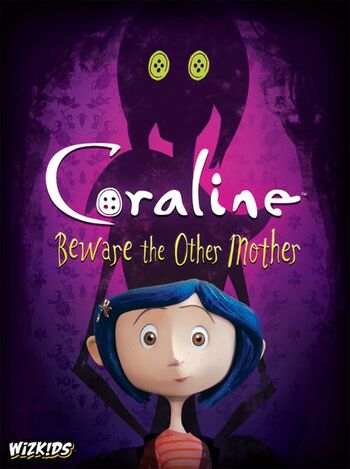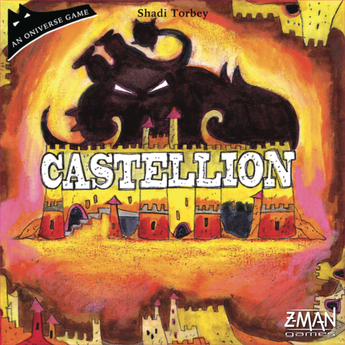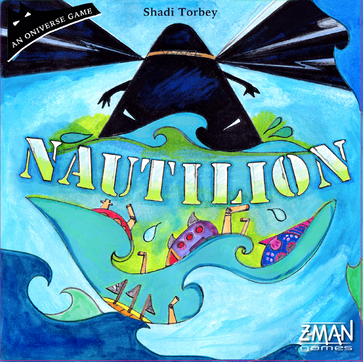 Full disclosure: WizKids sent me a review copy of Coraline. What is this game about? Coraline is a cooperative board game based on the movie version of Neil Gaiman's book. The game takes place at the climax of the film, when Coraline is trying to rescue her parents, escape the Beldam, and leave the Other World for good. You (and the other players, if you want those) represent Ghost Children who are helping Coraline in her quest. To win, Coraline must collect specific items from around the Other World version of her home. Then Coraline has to get back to the living room, and you have to play a card that allows you to win the game. On each turn, you will play one Coraline card from your hand, and do whatever the text on the card allows you to do. This can include revealing hidden items, moving Coraline, or bringing helpful characters from the film onto the board. (At the beginning, it's just Coraline and the Beldam.) After your turn, the Beldam gets to play a card from the Beldam deck, which means something bad is going to happen. The Beldam will essentially chase Coraline around the board, cause her to drop items, make other types of trouble, and advance the moon deck. The moon deck is one of the game's timers. You can lose the game either by running out of Coraline or Beldam cards, or by failing to find all of the required items before the moon deck fully advances. How does it play solo? Coraline is a cooperative game that largely plays the same at any player count. The main difference for you as a solo player is that you'll hold more cards in your hand. Overall Thoughts Coraline is an exciting theme, but this board game doesn't live up to the excitement of its source material. It might make a nice introductory cooperative game for younger players, or for players who love the theme. Its turn structure is very straightforward, which ought to make the game fairly accessible. The game also scales nicely, which means you don't have to change much between solo and multiplayer games. However, Coraline does not particularly capture its exciting theme. The game itself is so simple that there may not be much do it in the long run. You don't really feel like you're in desperate flight from the Beldam, either through the actions you take in the game or through the card art, which is shockingly repetitive and plain. There are very few stills from the movie, which I found disappointing given how great the film's aesthetic is. I also don't love that the game is so card driven that you can't do much without the right cards. This not only limits your in-game actions in strange ways, but leads to cards that contain a lot of text—a possible barrier to entry for younger people who might otherwise be a perfect audience for Coraline. You can pull off some cool combos and strategies with the cards, but overall I don't feel that they offer fully satisfying gameplay. Do I recommend it? Generally no. However, if you absolutely love Coraline, or have a game group for which this would be a great introductory game choice, then you might be its target audience. Overall Rating: 2.5 stars Rating Scale: 5 stars — I love it! 4 stars — I really like it. 3 stars — I like it. 2 stars — It's okay. 1 star — Meh.
0 Comments
 What is this game about? Urbion is the second game in Shadi Torbey's Oniverse series, and it's woefully out of print. Unlike Onirim and Sylvion, as well as all the other Oniverse games in circulation, Urbion has not received the deluxe treatment from Z-Man. The object of Urbion is to bring balance to each of the twelve cities in the game before your deck of cards runs out. These are cities of dreams, which means they are inhabited by both pleasant dreams and terrifying nightmares. Essentially, your goal is to place bad dream cards on one side of your city cards, place good dreams on the other, and perform balance checks to claim cities when they are in equilibrium. (The original name of this game was, in fact, Equilibrion.) However, it won't be as simple as that. Each turn, you will look at your hand of cards and play one. You'll have a mix of good and bad dreams, each with different numerical values from one to four. Your first option is to place a dream next to one of the city cards currently available (you can work on four at a time). You'll need to pay attention to the symbols on your dream and city cards, because they need to match. Alternatively, you can play a card to the discard pile. Discarding a card allows you to manipulate dreams already in play—as well as to bend placement rules a bit, which is a key ability in the fight for balance. The discard action also allows you to perform a balance check, which you'll need to do to collect cities. If you can bring all four cities into equilibrium and then do a balance check, you'll score an extra city card, so it can be very tempting to wait. Don't expect to go about your business uninterrupted, however—there are Chaos cards in your dream deck, and they don't want you to succeed in your task. When they appear, they will force you to make unpleasant choices that push your cities out of balance or cause you to discard dream cards. And because your deck is your timer, you don't want to lose too many. How does it play solo? Like its other Oniverse siblings, Urbion is technically for 1–2 players, but I really view it as a solo game. Overall Thoughts Urbion is, like all of the Oniverse games released to date, a good, enjoyable solo game. The turn structure is simple, but in-game decisions can be complicated, especially when choosing how to handle a chaos card. It's a fun puzzle to decide how to distribute your dream cards, and how to manipulate them to bring cities into balance. And I absolutely love the temptation to wait to perform a balance check, knowing that if you can bring all four cities into balance at once, the rewards are big—but also that yet another chaos card might be right around the corner. I find that the game gets better after a few plays, when I've gotten familiar with the contents of the deck again and have a sense of what might be left in there when I'm deciding what to discard. That said, Urbion is not a perfect game. Like its predecessor, Onirim, much of the game will depend on luck of the draw, and it's possible to have a bad run of cards that causes you to lose the game. It also feels like there is a bit less you can do in Urbion to mitigate your luck. In Onirim you might be able to use a Key to dispel a nightmare card, but in Urbion a chaos card will pretty much wreck you no matter what. My other quibble is with Urbion's graphic design. I love the art of the Oniverse, and Urbion is no different. However, the symbols on the dream and city cards are bland, and tend to blend into the colorful card art around them in a way that makes them easy to miss when you're just excited about playing a dream card. Do I recommend it? If you find an affordable copy, or if it comes back into print, then yes. But if you're feeling FOMO and a strong desire to complete your Oniverse collection, take a step back. This is a good game, but there are a lot of very good small card games you can get for a reasonable price. If you want to know how I feel about Urbion in comparison with other games in the Oniverse series, Jason Perez from ENGN and I ranked them in this video. Overall Rating: 3.5 stars Rating Scale: 5 stars — I love it! 4 stars — I really like it. 3 stars — I like it. 2 stars — It's okay. 1 star — Meh.  What is this game about? Castellion is a game set in Shadi Torbey's Oniverse. It's a tile-laying game in which you are building a castle, but not just any castle—you're in a race against the clock to create different formations of tiles before your fortress is tested by the enemy. Over the course of three different stages, you must create groups of the same type of tile (pyros, jugglers, chameleons, seers), arranged in either rows, columns, or squares, all within a castle that has a 6x6 limit. Although there is a simple, introductory version of the game, the regular and advanced games are where the excitement really starts. All games will involve three "tests," or sets of tile formations that you need to create within your castle. On each turn, you draw one tile and make a decision about it: either place it in your castle, or discard it and potentially use its power. All tiles will have a creature type (pyros, jugglers, chameleons, seers) and a shape (square, circle, or triangle). While you want to place matching creatures next to each other, there are further placement limitations based on shape. If a tile isn't working for you at the moment, you can discard it. Some tiles, when discarded, allow you to see into the future of your draw pile, others allow you to relocate tiles within our castle, and still others allow you to mine your discard pile for just the right piece. Many tile powers also allow you to disregard initial placement rules, which lets you manipulate your castle even more. However, you don't have all the time in the world to build your castle exactly the way you want it. Every so often, you will draw a traitor tile and have to decide what to do. Traitor tiles look like melting clocks, and their main purpose is to advance the game's timer—once you have placed a certain number of traitor tiles on your current test card, it is time to see whether you passed—and if you have failed to create the correct formations within your castle, you lose the game. There are, however, a few ways to stave off the inevitable test. Some traitor tiles have a black border, which means you cannot avoid them. But the ones without can be discarded, for a price. To get rid of them, you'll need to also destroy some of the tiles within your own castle. This can be a good way to clear out obsolete structures between test cards, but it can also be devastating. To avoid the possibility of drawing a traitor altogether, you can draw from the "safe" pile, but there is only a limited number of tiles in it, and you'll want to save them for a key moment. How does it play solo? Castellion is technically for 1–2 players, but I really think of it as a solo game. Enjoy it, solo squad! Overall Thoughts Castellion is a game that I generally like, but it's not my favorite in the Oniverse. (If you want to know where they all rank for me, you can check out this video I made with Jason Perez from Every Night is Game Night). I really enjoy several aspects of Castellion's gameplay, especially the way you can break the game by learning how to make the most of tile manipulation powers. In the "normal" version of the game, you can use tile powers by discarding them. In the advanced version of the game, you can access bigger powers by completing tile formations within your castle. With a little creativity, even destructive events like cannibalizing your castle to discard a traitor tile can be helpful and even fun. Learning how to both complete the spatial puzzle of Castellion and to make the most of tile powers is the absolute best part of the game. However, my delight in breaking the game is mirrored by my irritation with the placement rules in general. Once you learn the game, everything is fine, but Castellion comes with tile placement rules that don't always feel consistent. You can put pretty much anything in your foundation row of your castle, without regard for the shapes on the tiles, even though you can't normally place a tile adjacent to one with the same shape (circle, square, triangle). Once you leave that base level, however, the placement rules are in effect. While this makes sense intellectually, it gives me mixed messages visually, which sometimes breaks the "flow" of the game for me. Tile powers can also allow you to break the rules, and I often find myself wondering if I placed a tile illegally or if I used a tile power to get away with it. Also, if you're bothered by back luck in general, you should know that sometimes you just get a lot of traitor tiles at a bad time and lose the game. Castellion plays so quickly that this doesn't bother me too much, but you should be aware! Do I recommend it? Yes. I generally recommend all Oniverse games, and this one offers an interesting puzzle that is usually rewarding. Overall rating: 3.5 stars Rating Scale: 5 stars - I love it! 4 stars - I really like it. 3 stars - I like it. 2 stars - It's okay. 1 star - Meh.  What is this game about? Nautilion is an Oniverse game, and it is Shady Torbey's attempt to make roll and move into an interesting board game mechanism. In Nautilion, you are in a race against the Phantom, an evil ship that is headed towards your happy island home. Your goal is to gather a complete crew and reach the Abyss to confront evil before the enemy reaches your island. You and Phantom will even pass each other on the way! To set up the game, you place crew tokens to form a path from your island to the Abyss. On each turn, you will roll three dice, and you will assign one to yourself, one to the Phantom, and one to a more distant evil called the Dark House. You and the Phantom will each move the number of pips on your assigned dice. You'll have a chance to either hire the crew you land on or convert it into a token to use later. These tokens are typically used on spells that allow you to manipulate the dice or the path ahead of you to get the crew members you need. When the Phantom moves, it will gobble up whatever potential crew member it lands on, removing it from the game. And if you assign a die with a value of 3 or 4 to the Dark House, it will either consume one of your tokens or remove a crew member from your game board. You will either make it to the Abyss with a complete crew before the Phantom arrives in your homeland, or you lose the game. To add to the challenge, you can't just hire any old crew member—you need to collect members 1–9, and once you have placed someone on your player mat, you can only put new crew in adjoining spaces. There are several different ship boards you can play with, some of which are more challenging than others. Nautilion also comes with a number of expansions to enhance the base game. You will end up consistently playing with the Mages, who add another element to your crew collection efforts but who also help you with their magic. The others add fun challenges such as a reef that impedes movement, or "mercenaries" who allow you and the Phantom to fight it out when you meet partway across the sea. You can also give yourself and the Dark House special powers that change the game in interesting ways. How does it pay solo? Nautilion is technically for 1–2 players, but it's very much designed for solo play. Enjoy! Overall Thoughts Shady Torbey designed Nautilion as a way to make roll and move into something fun, and I would say that he has succeeded. Depending on what you roll, deciding what dice to assign to whom can be surprisingly nerve wracking. If you move too conservatively, the Phantom might end up making bigger moves and beating you to its goal space. But if you assign high-value dice to yourself, you might end up skipping over crew members you really need. And you certainly don't want to assign high-value dice to the Dark House, especially if you're at the point where it will force you to lose crew members. Nautilion is also very easy to learn and quick to play, which makes it ideal for a relaxing afternoon or evening of solo gaming. While the base game will quickly become a bit vanilla, the expansions—particularly Mages—are worthy additions to the game that make it more interesting. A quick word of warning, though: Nautilion does involve some interesting decisions, but it is still a dice game, and it's possible to get very unlucky. If you're thinking about picking it up, be aware that luck will be a major factor in the game. My main quibble with Nautilion, however, is the fact that you make a path out of the crew tokens instead of having an actual game board. Chunks of your path will disappear throughout the game as both you and the Phantom pick up crew tokens, and because your path will curve, it's possible to get mixed up, especially if you're as messy as I am. (No beautiful, perfectly-aligned spiral pathways for me!) All those separate crew tokens also mean that Nautilion is mildly annoying to set up, which makes me less likely to play it multiple times in a row. Do I recommend it? If you're looking for an interesting small box solitaire game, then yes! You really can't go wrong with the Oniverse. Overall Rating: 3.5 stars Rating Scale: 5 stars — I love it! 4 stars — I really like it. 3 stars — I like it. 2 stars — It's okay. 1 star — Meh. |
AuthorMy name is Liz Davidson, and I play solo board games. A lot of solo board games... Archives
August 2021
Categories
All
|
 RSS Feed
RSS Feed